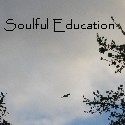I've been pulling my hair out a bit about teaching fifth grade-- there is SO much to cover this year! India, Persia, Babylon (or is it Mesopotamia?), Egypt, Greece, Botany, Geometry... it makes my head spin! Living in a German-speaking region, we have zilch available locally. And as far as I know, I'm the only Waldorf-inspired homeschooler east of the English Channel, so I can't even have a peek before I buy... unless it's online somewhere.
Now that my first two shipments have arrived, I'm happy to report that I've made some very good, albeit blind, purchases:
Ancient Mythologies
by Charles Kovacs
I love the way Kovacs' books read. It's like you're listening in on lessons, and you are, essentially. He goes through various myths of India, Persia, Babylon, and Egypt in this conversational, talking to ten-year-olds way. The stories evolve fluidly in the conversation, and the conversation itself appears to be the red-line that ties everything together. The only downside is that you have to follow the conversation to really know where you are.... which the more I look at it, the less it seems like a bad thing. His stories really suck you in. I adored his Man and Animal book, so I'm sure I'll get a lot of use out of it.
Chapters in Ancient History (in a biographic vein)
compiled by Dorothy Harrer
To be honest, I'm not very fond of spiral-bound books. It's a pet-peeve, I know, but some of the ones out there are just hard to navigate through, and regardless of the content, harder still to find on the bookshelf. They just all look the same! However, I am so glad I purchased this! It contains stories from India, Persia, Mesopotamia, Egypt, and Greece. It even contains biographical tales of the major figures in Ancient Greece, which means that I may not have to purchase any other texts... like a separate copy of Gilgamesh. I can just boot that sucker out of my Amazon wishlist (along with all those Ancient Greek biographies) and move on. The best part is that each section comes with a quote (presumably from an ancient text of that time) along with a summary of the relationship between the people of that time and the celestial sphere, or heaven and gods. I find that simple explanation priceless, because honestly, this is all new material to me.
The language of these stories is very different from the Kovacs book mentioned above. Harrer's stories have more of an ancient feel to them, which is sometimes great and sometimes just plain wordy. Her sections for each cultural epoch are fairly small, and with few exceptions, different stories than what is included in the Kovacs book. I think I'll have to pick and choose between them.
String, Straightedge, and Shadow: The Story of Geometry
by Julia E. Diggins
I took Geometry my sophomore year in high school, and I simply loathed it. It bored me to tears, and perhaps because of the way it was taught, has since been this abstract thing I've felt absolutely no kinship with or interest in. That said, I can tell you that this book looks fantastic! It tells the story of geometry, from the oldest times through its progression to Ancient Greece. It's packed with eye-candy drawings, both of geometrical relationships and the people who used them (guys in butt-flaps and togas) and how they used them. It looks so interesting, that I'm confident this book is going to change everything for me!
Botany
by Charles Kovacs
I haven't yet given this the attention it deserves. But from first glance it appears to be great, in Kovacs conversational-style, and packed with information. The text includes all the different plant families, plants used by people (grains, coffee, etc.), and a bit about bees. Unlike his Man and Animal book though, it doesn't have accompanying artwork, so I'm less apt to delve in immediately. I appreciate the simplicity of his writing-style though, so I'm sure I'll get a lot of use out of it... though honestly, at first glance I like the following book better.
The Living World of Plants
by Dr. Gerbert Grohmann
This book is talked up as THE book to use for teaching botany, and really, it is THE book. It's written for children, so the language is simplistic (but not stupid) and to the point. Better yet, there are pictures; throughout the book are simple line-drawings corresponding to the discussion at hand. I appreciate that. It looks excellent! Essentially, this book has the same textual feel as Kovacs book, only with pictures.
I'm planning to combine these botany books with the beautiful drawing help in Drawing from the Book of Nature.
. . . . .
Since I'm talking fifth grade, a review of this book already on my bookshelf seems necessary...
Teaching History I: The Ancient Civilizations and the Fourth Cultural Epoch
by Roy Wilkinson
I bought this for cheap a couple of years ago from a local homeschooler who was cleaning off her shelves. It's good, it's interesting, but it's not enough by itself. This is the "how-to" and "why" guide to teaching ancient history. It has the cliff-notes version of the stories and gives a lengthy summary of the places and times at hand. There's even very small biographical summaries of the major Greek folks. But I wouldn't call it enlivened. It's dry and informative in that Roy Wilkinson style, which, the more I look at it notice is the point. And that has it's place. It's the kind of reading for me that takes a bit of concentration and note-taking... the kind you can't do with kids jumping on the couch. If I get some quiet moments, maybe I'll read more of it.







Cool stash of books! I hope they work out well for you.
ReplyDeleteEven though we are only starting 3rd grade this year, I still enjoy reading what you have to say. I too dislike the spiral bound books, but love Dorothy Harrer. I am using Roy Wilkinson's Old Testament book this year and like it very much, as well as his little Practical Activities booklet. Now I will go have a look around at your third grade link.
ReplyDelete